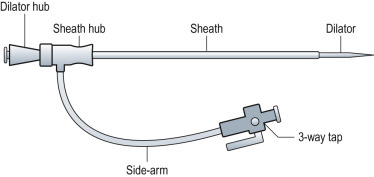Physical Address
304 North Cardinal St.
Dorchester Center, MA 02124
Sheaths and guide-catheters are designed to allow the coaxial passage of other devices. There is overlap between the structure and function and recently, introducer guides have developed as a crossover group. There are differences in sizing and usage, so the devices will be discussed separately.
Sheaths act as atraumatic access conduits for other equipment. There are two main designs: the vascular access sheath and the peel away sheath.
Vascular sheaths are often the primary vascular access; they are invaluable for any case that is likely to use more than one catheter, as they greatly simplify catheter exchange, maintain guidewire position and prevent bleeding at the puncture site.
The sheath comprises two parts, they are often packaged with a short guidewire, which is only used for insertion.
A hollow plastic tube connected to a haemostatic valve with a side-arm for flushing ( Fig. 14.1 ). Some sheaths have marker bands at the end of the sheath, which can help if you will potentially have to perform an intervention close to the tip of the sheath. Some sheaths have thicker, kink resistant walls and greater column strength than simple access sheaths.

A central dilator. This usually ‘clicks’ into place in the sheath hub. The dilator has a tapered tip to facilitate passage over a guidewire into the access vessel and minimize transition to the sheath tubing.
Familiarize yourself with how to assemble the sheath and remove the dilator.
this varies from tiny 2.7Fr microaccess sheaths to behemoths of over 20Fr.
Remember that the sheath size describes the calibre of catheter it will accept , e.g. a 5Fr sheath takes a 5Fr catheter but clearly will have a larger external diameter. A typical thin walled 5f sheath has an approximately 6Fr outer diameter, a braided reinforced sheath will be correspondingly larger.
Standard sheaths are usually compatible with 0.035 inch wires. Microsheaths for instance used in the pedal circulation may require an 0.014inch wire.
A typical vascular access sheath is about 15 cm long. There are also longer sheaths, which are usually used when additional support is needed.
Do not forget to take the length of the sheath into account when choosing catheters, balloons, guidewires, etc.
You do not want to change horses midstream, so think about what equipment you are likely to need to introduce, e.g. angioplasty balloons/stents, and choose a sheath large enough to allow this.
In general, use the shortest sheath that will do the job but there are occasions when a longer sheath can be helpful, e.g. when working over the aortic bifurcation. A long sheath can also be used for angiography by injecting through the sidearm.
Consider a reinforced sheath whenever kinking is likely to be an issue.
The sheath is flushed with heparinized saline via the sidearm.
The sheath is then assembled by inserting the dilator. This usually ‘clicks’ into place.
The sheath is advanced over a guidewire in the case of a vascular access sheath; this is usually up to the hub.
The hub is then held in place while the dilator is removed, either together with the short guidewire or simply backed off over a longer wire.
Sheaths have a large dead space and should be flushed regularly. This is easily overlooked when focusing on the catheter and guidewire some distance away. Open the tap and aspirate until flowing blood is obtained, then flush with clear saline. Remember you cannot flush while the dilator or equivalent diameter catheter is in situ.
This should be easy, after all that is what the sheath is for, but the haemostatic valve can sometimes cause a problem.
Become a Clinical Tree membership for Full access and enjoy Unlimited articles
If you are a member. Log in here